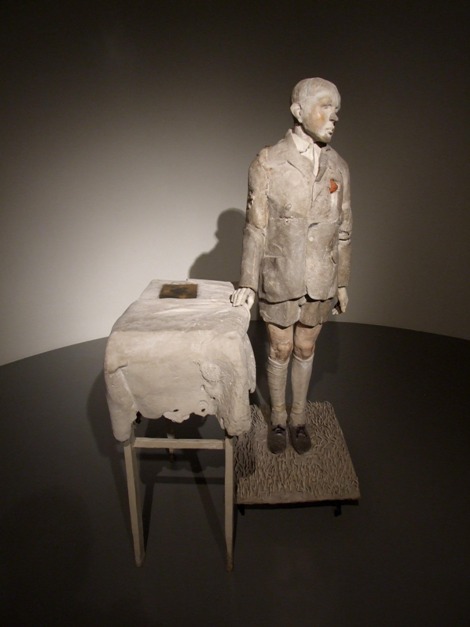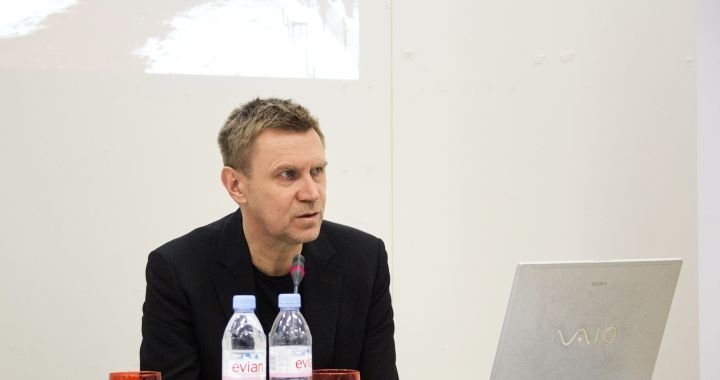
Running fingers through salt
An interview with Polish artist Mirosław Bałka
Sergej Timofejev
19/01/2015
At the end of 2014 possibly one of the most famous contemporary Polish artists Mirosław Bałka was invited to appear at the contemporary art center kim? in Riga. Mirosław is a serene man of 56 years old with a quiet voice. He grew up in a Polish province where western pop icons were frowned upon, however there was an abundance of images and depictions of saints, and attending church was considered a routine part of everyday life. He graduated from the Warsaw Academy of Fine Arts as a sculptor, but over time became one of those artists who widened the horizons and possibilities of this medium in the contemporary art world by depriving his works of visible figurativism and forcing the audience to feel their own figurative selves. He creates his works out of soap, ash, air and emptiness. And sometimes out of heat. In general, he creates wonders, although they are quite materialistic. Our interview happened right in the office of the kim? art center (recorded on tape were also the sounds of the exposition, so the overall result was somewhat of a soundtrack from an esoteric film) and we discussed the relationship of his art and the sacred structures and shapes of Catholicism, the deer in front of a fence, and why we want to run our fingers through salt to verify the reality of the world.
Miroslaw Balka. Remembrance of the First Holy Communion. 1985. Photo: panigondu.blogspot.com
Your first famous sculpture is from 1985, it was your university diploma work and it plays with the scenario of the first Communion. It seems that it was a very important and symbolic work for you, considering the work touches a religious theme. But at the same time you used everyday objects like concrete.
Concrete is a very solid material, it is actually used quite often in sculpture. It is more important to me that the concrete has a specific tone, the color of skin or the color of a white shirt, and I didn’t use paints to achieve this. I applied crushed or powdered materials mixed with the concrete to achieve particular tones. For example, powdered marble for a white color, or crushed red brick to simulate the color of human skin.
The people who came to view your work had to arrive at the place on a specially rented bus and then walk one and a half kilometers. It seems that it is quite important to you how the actual process of greeting your artworks happens.
This graduating work was in the sculpture department at the Warsaw Academy of Fine Art. The idea was to pull people out of the building and the academy’s space, to change the perspective from the comfortable harmless and isolated environment and into the environment of everyday life. The actual place was an abandoned house in a small village 30 kilometers from the city. In those times (in 1985) it was a rather unusual setting for exhibiting art. Only later, already in the 90s, it became quite popular to insert art into the everyday environment. And still, usually this meant a city, but my art piece was in a village. I worked on the actual sculpture in the academy, then I transported it to that house together with a colleague. And immediately we were surrounded by the local children and adolescents who were interested in what was going on and asked repeatedly whether we needed any help. Today they are all around 40 years old probably, and sometimes I think about what would it be like to go back to the village and talk to them, to ask whether they remember all of this... Anyway, so they ended up helping me. One of the boys, dressed as a scout, was supposed to stop the bus containing the professors and viewers. Then he had to explain to the passengers that they needed to get off and follow him. It was a rather responsible task, one worthy of an adult. After that, at the entrance, other children dressed in white met the guests. These children volunteered to participate and the dress code was their idea. For them it was like participating in some important religious ceremony, because people in villages dressed smart for events related to religion, for example weddings and funerals.
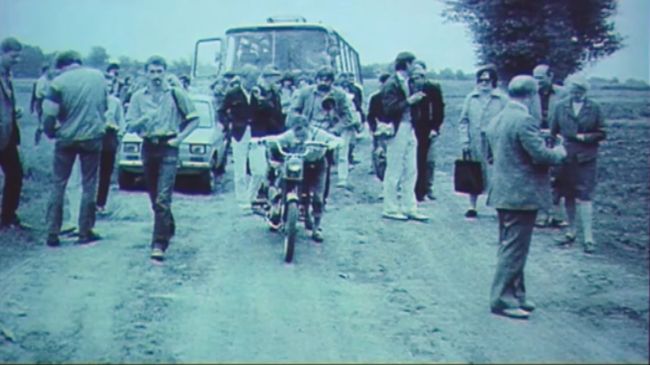
From here the guests walked for one and a half kilometers
So the children greeted these people and gave out normal sewing needles from hands clad in white gloves. Then the guests had to proceed to a rather dark room, where in a cabinet I hid a recorder which played a tape with the sound of a heart beating. In those times it was very difficult to find such a recording. Nowadays Christian Boltanski collects heartbeat sounds, and on the internet one can find and download many such recordings. However back then we made up the sound by rhythmically knocking on a table. It just so happened that when we were recording this sound, coincidentally on the street there was a procession of Corpus Christi, as it usually happens in June. They walked and sang religious hymns. That is how the whole thing was recorded - their singing first got nearer, then further away, all in the course of 6-7 minutes. This was the recording that was playing in the dark room.
The actual sculpture was of an adolescent boy standing by a table, and there was a tailor’s pincushion inserted into the place of the “heart”. A few pins and needles were already thrust in it. So the people walked around with their given needles and didn’t know what to do with them. It was rather dark... and after about 5 minutes at my signal the boys opened windows. And everyone saw those needles thrust in the pincushion...
Did anyone put their needle in the pincushion?
Yes, a few students... but the professors were embarrassed and disheartened. Afterward everyone went to the other side of the house, where my colleague was going to do a presentation. Later our professors and examiners could not ask a single question. They felt completely out of context. There was something real in front of them, but it didn’t sit well with the academic discourse.
Hence I gave a little speech, about how I worked on the project, about the relationship with the children, about the different surprises that popped up with this piece. I ended my speech with a remark that I wouldn’t be surprised if something happened right at that moment. And right at that moment there was thunder and a bit of rain. It was on 13 July, a very mystical summer day. Everybody went back to the bus. The children walked around with a jar for donations “to pay for transportation”. I divided that money between the children and gave them specially prepared books with the stamp of the academy... I also brought them bananas at some point, because in those times bananas were something incredible and exotic. Then the bus went back to where it came from, and we were told that the works needed to be back in the academy by the next morning.
To return them back to some context...
Yes, the art context. But this was really an experience that gave me a lot. Everything happened on many different levels and outside the usual harmless zone.
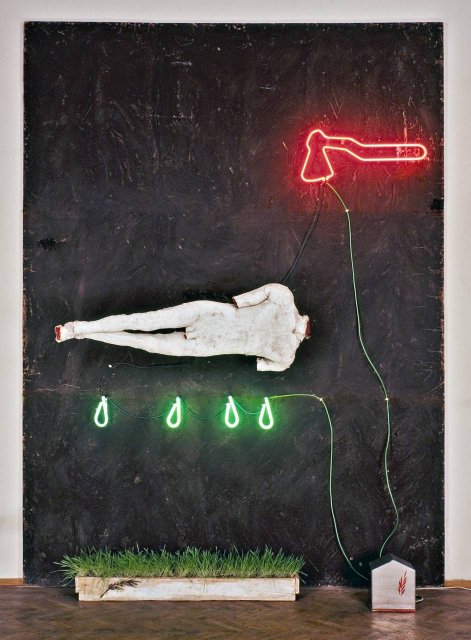
Miroslaw Balka. Św.Wojciech. 1987
Do you come from a religious family?
Yes, a very religious one. Not in the sense of meticulously studying the Bible, but practicing the religion. This was not a family of intellectuals, they were pretty much normal people, peasants and workers. Faith for them had the same place as it did during the Middle Ages. You go to church to seek an audience with God, and then you listen to the priest because those are the rules. I also followed the rules until I turned 18 years old, that was when I said I would no longer attend church. Nevertheless I gained that powerful fuel for my art because of all the previous times spent in church, and the Catholic iconography, especially the depiction of saints, became the object of my interpretation.
My grandfather was a very famous engraver of tombs. Every Sunday together with my grandmother they invited to dinner the local priest from the city’s main church. This is how I could observe the priest in real life, sitting at the table, eating dinner, drinking. He was no longer such a “saint”... This also affected the opposition emerging inside of me to religion as a form of hypocrisy.
But I don’t see this opposition clearly in your works, rather the usage of these ceremonial constructs in an art sphere. Their shift to another semantic field...
Yes, the opposition was more during my adolescence. Then I was really trying to apply these ideas, to construct an exposition in such a way as to create a feeling in the viewer similar to the feeling one gets when entering a church. Sometimes I tried to lay out the work as a sort of altar in accordance with the viewer. I used these things because I grew up surrounded by all this. During my childhood the church ceremonies were the only public affairs in which I partook, every Sunday. The church with many people. It was an opportunity to feel or to test out my own individual presence in the midst of a crowd. I wasn’t exactly overjoyed, but this was my situation.
I only visited Poland once, in the beginning of the 90s. I remember in Szczecin I stumbled upon a festive church service. There were a lot of young people, and at one point, people began to turn around to face each other, strangers on either side, and to wish each other good things. I was very impressed ...
Yes, that is a relatively new tradition, it started at the beginning of the 90s. The priest pronounces “Let us exchange the signs of peace and love” and people start shaking each others’ hands. Incidentally this is a good thing, because people see others in the church when they look at those who surround them. Usually the structure of the Mass is to face the priest all the time and to look only in one direction. If we were to use the metaphor of the sheep and the good pastor, then here the “sheep” don’t only look at the pastor, but also at each other, or at least at the nearby “sheep”. By the way, sheep are animals that became a theme in one of my sculptures because of the same iconographic meaning...
And what was this project?
This is a sculpture that was exhibited last year in Venice, in Arsenal, and in the Massimiliano Gioni exposition in the section curated by Cindy Sherman. I have to say that this section exhibited really strange works (he chuckles). This is where I exhibited the work from 1988 called “Black Pope and Black Sheep”: a figure representing a black Pope sitting down with a black sheep by him. This work stood in storage in my studio for 20 years, and finally one curator, Lynne Cooke, found it a couple of years ago. We were preparing for the exposition at the Museo Reina Sofia and she liked this work, so conservationists from the museum renewed it a bit. After that the work travelled to another museum in New York, then Venice, and now it is in the collection of the Museum of Modern Art in Warsaw.
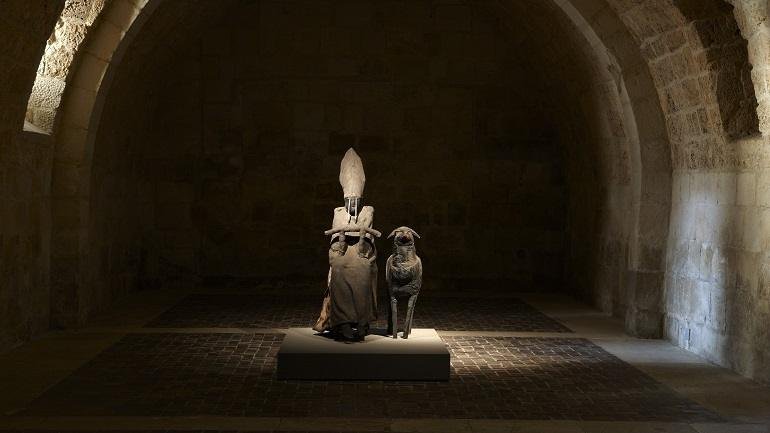
“Black Pope and Black Sheep” in the Museo Reina Sofia, Spain. Photo: https://museoreinasofia.es
It is quite amusing that this work waited 20 years to begin its tour of international recognition. The sculpture played with the phenomenon of the “black Pope”, because during that time the Nostradamus figure was quite important even by word of mouth, his books were rare, and people shared their rather unattractive printed copies. In the books he mentions that when the "Black Pope" comes, it will be the beginning of the end of the world. And the black sheep that will appear there will be a "bad" sheep ...
When you travel, or when you arrive somewhere, do you visit the churches in those places?
Yes, I visit the churches and I visit the graveyards, at least in Europe. In America it is different, but in Europe it is easy, every center of any Old Town will have a few churches. I don’t visit them for the religious aspects, but maybe I want to remember something from the past, to sit in silence.
How do church representatives in Poland perceive your artwork? Is there any noticeable reaction?
I have gone through different periods in my art, because I have been doing it for a quarter of a century already. The works that are tied in with religion and the representations of saints are more from the 80s, it was a different time. From 1990, actually after the exposition called “Good God”...(he chuckles) I moved toward situations where figurativism dissolves and only a shadow of a figure remains rather than a figure itself. I turned to objects that are connected to the body, but they are not figurative. That is why it is hard to say what the representatives of the Catholic circles think about my work, because I doubt that what I do interests them, as for them it is harder to understand...
What it is about...
Yes, of course it was easier to find some contact with the works that I did in the 80s. On the other hand, the discourse of art criticism was very underdeveloped in Poland, we would do a show and then discuss it only with colleagues. Additionally anything that touched upon religion but didn’t come from the “on the knees” prayer position, did not cause any violent counter-reactions in those communist times. Nowadays in Poland a video projection with the accompaniment of religion hymns at an exhibition could get egged. Also back in those days reactions to art were never too violent anyway, it’s only today that anybody could publicly say anything that comes to mind. It is good that people can express their opinion, but if they are doing it by destroying the works of others, then there is nothing good in that. It is partially the influence of the internet, where one can say anything about other people without any consequences. Nowadays people in Poland that are tied to the Catholic religion are trying to occupy the spaces that do not belong or relate to them, such as exhibition spaces. For instance, in the beginning of 2014 they blocked a theater performance at the big theater festival in Poland, because the director from Spain put on something about Christ. Firstly they campaigned on the internet and a few thousand people supported the idea of showing up to the theater and starting a rout during the performance. The organizers got scared and the performance did not go through.
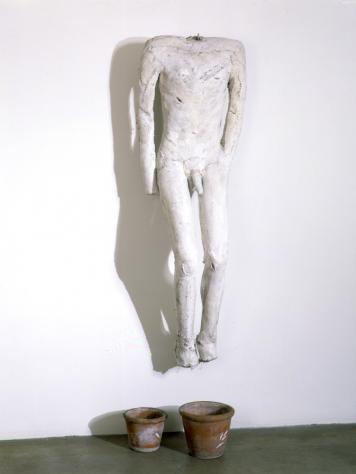
Miroslaw Balka. History. 1988
Not too long ago I interviewed another person from Poland, the director Agnieszka Holland, who spoke about the shortage of big fresh ideas, which is why people become so easily manipulated by the nationalistic and radically religious concepts.
I think that this is quite true, especially if we are talking about Europe. America is a completely different world, because in Europe often we have to deal with the past and the conflicts that arose due to some ideas.
When I was a young man, I grew up with the concept of No Future, and all around me it really was the time of No Future.
Are you talking about punk culture?
Poland was too poor to generate punk culture, as it arose from a consumerist society. Punk in Poland looked kind of strange, but the motto behind No Future was very relevant. I was graduating the academy and I knew that I had no perspective job, or any space where I could get exhibited. I didn’t have any money, or a studio, and no plans about what to undertake. Pretty much No Future. However, from the current time’s perspective I can say that at least we had some ideas. Today it is extremely hard to generate new ideas, including religious ones. And the only religion that has a significant power consolidated by the energy of an idea is Islam.
And even the idea of democracy is completely...
Fragmented?
Yes, that is the appropriate word. So now the times are truly difficult, especially for the youth, whereas I will somehow manage with my 56 years of experience and the experience of several systems. But for the youth it is not easy. There is a deconstruction of society and family occurring at the moment. At some point I also had the feeling that the classic model of a family is not quite right. However, without the presence of family in our lives, when we are all alone with our iPads, iPhones and computers, we are witnessing a situation which cultivates loneliness in people. This situation will only grow further. I do not see what there is to change for the better, what technology we have to create to humanize everything. Maybe something would emerge, because technological progress is so swift. It is difficult to come up with a solution to the problem now, a solution that doesn’t require a battery pack. Earlier ideas were more unplugged.
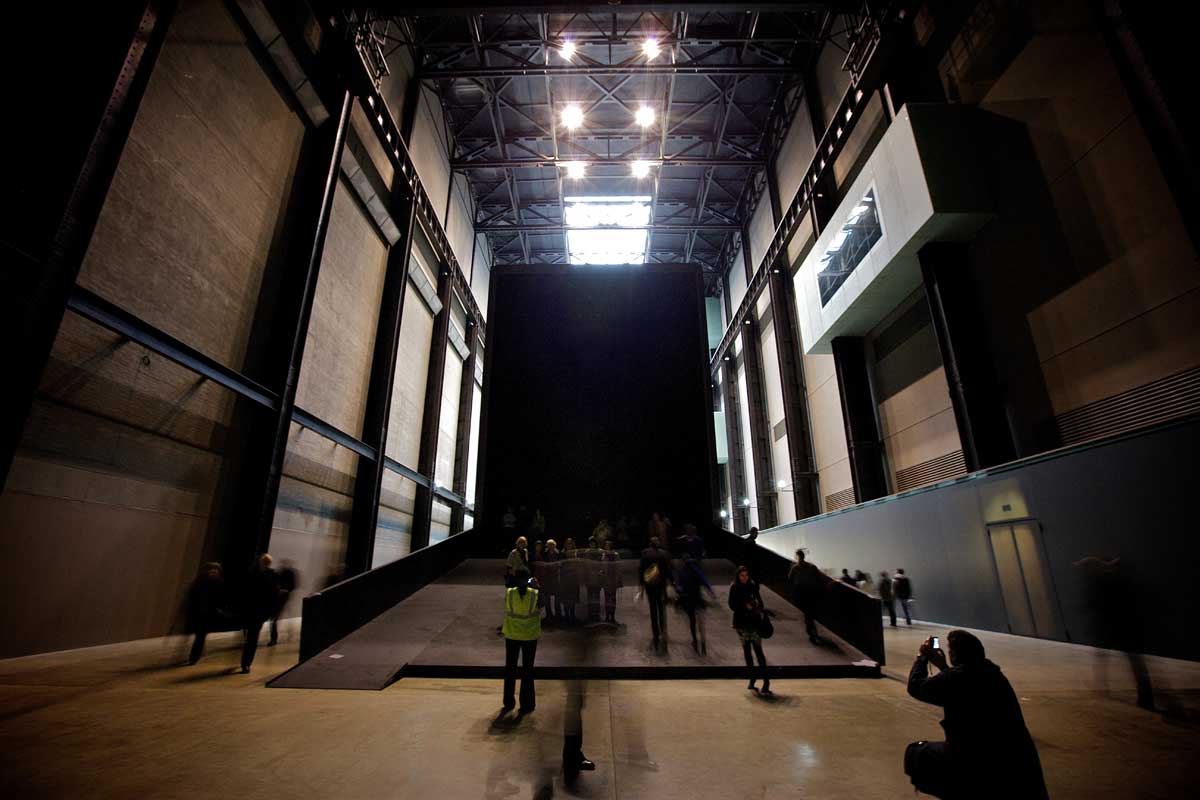
Miroslaw Balka. How It Is. 2009
I would like to turn to another artwork that was somewhat important for your development, How It Is (2009), exhibited at the Tate Modern. It is an object that caused a further feeling of dissolution, disappearance, rather than a direction to something or an achievement of something... Maybe there is an another aspect of another religious worldview, say, a Buddhist one?
I think that in order for us to talk about this work, we need to describe the space in which it was exhibited. Tate Modern is a place where one can go for free, one does not require a ticket. It is a truly tourist mecca. After visiting the St Paul cathedral, you can walk on the Millennium Bridge, where on the banks of the river Thames people take millions of photographs each day, because everywhere around is so beautiful. It is almost like a never-ending flow of people on top of the real flow of the river. And therefore this flow of people streams into the Tate... The idea of this work was to give the people some tranquility, a chance to calm down and catch their breath. The sculpture in itself is an enormous steel box, and in order to enter it you must walk around it, about 30 meters to the ramp that leads inside. Therefore, first you walk around the form, and you can even walk underneath it, as it is propped up two meters above the ground, and it is as if you are getting used to the construction, it seems very lucid and voluminous. And finally you come to the ramp, you turn towards it, and you see a thickening darkness inside. You walk inside and it becomes even darker with each step. There is a moment when you suddenly question whether you should go any further. Is this still the same steel box that you walked around for 30 meters, or is this something different? What is going to happen now? And this is where the question pops up, “How It Is?” when a considerably real voluminous form transfigures into something incomprehensible, something that you are not sure about. There isn’t 100% darkness, maybe only 70%, but that is enough to lose confidence in your own representation of this space. Here is where you need to make a decision whether to allow your curiosity to go further inside. The majority of people do just that. The walls are covered in a special upholstery (flock), so when you touch them, they are unexpectedly soft. When you walked around the object, you saw only the hard steel, but inside everything is different. This is the most light-absorbing material, which is why I chose it, but it also added a new surprising effect of touch. As if the inside, in contrast to the outside impressions, is something completely different, like a toy, something pleasant...
Like a mother’s womb...
And so for people arriving from daylight, walking into this black hole in the midst of all the light, was an important aspect for me. I wanted them to question whether everything is as it seems. On the other hand, all these people come with their photo cameras and they start to take photos inside the object, because of course they have to prove that they have been inside. But the photos don’t usually come out because it is so dark. Nowadays to get a bad quality blurry photo is a strange phenomenon. Because of these mediocre photos the people shift from the position of the visitor to the position of the observer. If the photos don’t come out right, then they can remember the place and what happened inside better than if they took a photo, because otherwise they would just download the photo onto the computer, and it becomes one of thousands of saved images. Here however you can activate your own memory, not the memory of your SD-card. This is also connected to Samuel Beckett’s book which is called the same “How It Is” and also Michael Jackson’s touring project “This Is It”. Around that time he was going to start his grand world tour in London with this title, but he did not accomplish it because he died. This was an interesting dialogue: How It Is / This Is It. I was thinking about it when I chose those words. There is also an interesting emphasis for those who were born in the same year as I, in 1958. This was the same year that Michael, Madonna and Prince were born. I have a number of friends and acquaintances that were also born in 1958. In the global outlook this was an optimistic generation which emerged after the war and after the war wounds started slowly healing with time in the next couple of decades.
This leads us to another important theme for you - rethinking the experience of the catastrophe that was World War II. Also the attempt to enter the signs and the reminders of this into the modern context?. Some of your works are dedicated to this ...
Many of those are video works, because I had the idea of traveling with a videocamera to places associated in the human memory with the “dark pages of history”, to places where concentration camps or death camps used to be. I traveled there with a videocamera in my pocket. It was essential for me that cameras have become quite small in size, so that I could hide them. I could be incognito and not stand out from the crowd. So I just strolled around, sometimes noticing something that I wanted to film. This wasn’t some historical narrative or an educational program about the holocaust. For me the important part was my own presence in these places: on the banks of the pond in Birkenau where the ashes of the cremated were thrown out, in the shower rooms in Majdanek. I was always trying to concentrate on my presence in these places, my physical presence. This was reflected partially in the fact that the camera shook and the picture was not always clear. And once I noticed a wandering group of young deer, which later became part of my artwork “Bambi”. When I filmed them, my hands shook because it was so unexpected to see young deer through barbed wire with the remains of the ovens and barracks at Birkenau in the background.
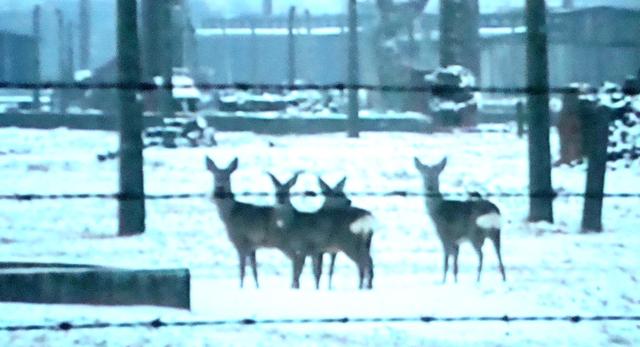
Miroslaw Balka. Bambi. 2003
As I understand, you would choose only about 10 seconds from an hour long video...
Yes, exactly. Hundreds of Mini-DV tapes, from which there are maybe a couple of works. Usually I found an episode and fixated on it, repeated it like a mantra. And because of the never-ending repetition, this little piece of the video received the qualities of sculpture. You cannot perceive something so short and repeated constantly as a linear narrative.
Also it was very important to me how I laid out the video projection and what I showed it on. I often used the floor: I lay down special steel frames 10 cm high and filled the framed space with very fine salt. It became an excellent surface, a superb white screen.
This too becomes a kind of sculpture...
Of course, it’s like an image projected onto sculpture, a patina on the surface of the sculpture. And the salt itself is associated with memories of the past, dried up tears, dried up sweat, salt on the wounds, and pain. For me these are very significant in the perception of the works, the same way that the physical presence of the viewer is significant - how the viewer moves around in the space and how the viewer sees everything. That is why yesterday when during the discussion I was asked about my journey away from figurative art toward non-figurative, I said that now the function of figures in my works is given to the viewers. I create situations in which you can feel your own body become an element of the exposition (due to the lack of any other body). You find yourself in an emptiness controlled by the artist or a space with a minimum amount of elements... Like the exposition I recently executed in Kiasma where I hid heating cables in the walls and called it “Touch Me, Find Me”. The viewers simply touched the walls and at some point found the difference where it got warm. So you walk into an empty space, the walls are a little bit dirty because they are constantly touched. And there is something in that, the same as the difference in temperature. In this moment your presence as a viewer grows, as you are not just the eyes but also the body. An exhibition is not just an episode of observing something and moving your head side to side.
Your objects also use smell, like those made out of soap. You also used temperature in the work to commemorate those who died on the ferry “Estonia”.
Sometimes I also use wind, the movement of air and ventilator fans. For example last year in Rio de Janeiro. Or also in Karlsruhe in the Kunsthalle, where they asked me to have a kind of intervention into their permanent collection in which they hold many wonderful works from the early Renaissance and Northern European art such as Grünewald or Dürer. My idea was to create a kind of restricted corridor through all the halls leading to a room with powerful ventilator fans. The strong stream of air almost knocked you off your feet. This was in some way connected to the pictures on the walls, which also showed human physicality: the bodies of saints, martyrs, crucifixion. The viewer suddenly felt his own body because he was “touched”. It was a signal to show that you are also physical. You see the bodies that are tortured and executed, but this can also happen to you, this possibility exists.
I also find materials such as water important. As Thomas Mann wrote, we are made up of 75% water. To show water, even if it is just a water stream, is also to show a hint of physicality. I also use ash. In the work Dead End I covered the walls about 2.5 meters high with a layer of ash. People really wanted to touch the walls, to have an effect on the stability of the surface. The same goes for the salt on the floor, as it often gets touched, because people are curious about it. And they end up destroying the surface, and then they want to cover it up as soon as possible and destroy the surface even more. (Laughs.) And this, in turn, reminds us what St. Thomas did: he had to check the accuracy of the Christ’s wounds by dipping his fingers into the holes to check whether they were real, whether anything is real at all.
These aspects are important to me. Where are the borders of trust? You wouldn’t touch a painting with your fingers, but sculpture makes you want to touch it, to knock on it to understand what it is made of. The presence of the body, the role of physicality - it’s a different context, in which there are still perspectives for sculpture no longer figurative but dedicated to a different figure - the figure of the viewer.
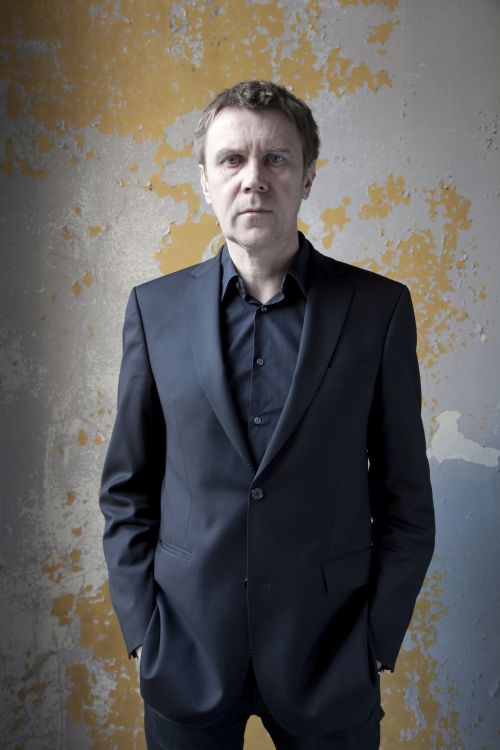
Photo: Szymon Rogiński, magazynszum.pl
